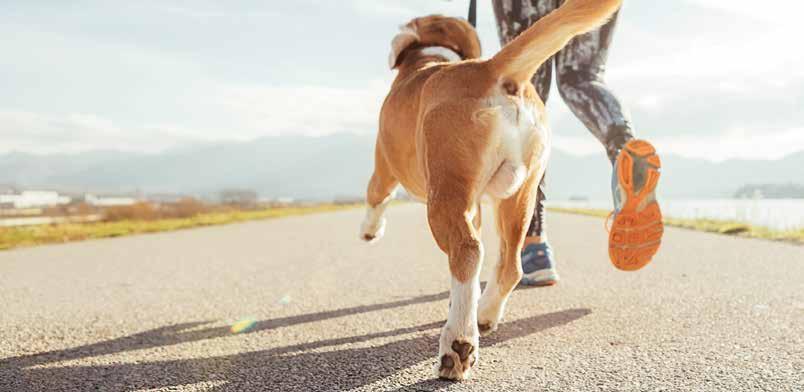
3 minute read
WALKING THE DOG
from THE WAG magazine
Avoiding discomfort and injury
By Penny Lex
Advertisement
Your dog gives you “the look.” “Ahhh yes, I bet it’s time for a walk, huh?” You snap on the leash and out the door you go—not thinking about the shoes you might be wearing, the leash you will be using, or even the fact that you’re not bringing water for hydration. If you’re not doing it right, repetitive dog walking can lead to various discomforts for you, and your dog—the majority of which can be easily avoided.
The proverbial pull
Many women are all too familiar with the pain that can result from carrying a handbag or tote on the same shoulder day after day. Continually walking a dog that pulls on the leash is very similar. The repetitive pull can irritate the muscles and joints of the arm, shoulder, and neck. Shepherd’s strain is a common injury to dog-walkers resulting from the pet pulling on the leash. If your dog decides to suddenly bolt while your arm is extended, you may sprain your wrist or even dislocate your shoulder.
Ken Greenstreet PT, owner of Fountain Hills Physical Therapy, says “most of the dog-related injuries we see are shoulder, elbow, and wrist injuries from falls while walking the dog. Some injuries are from the dog lunging, and some are from people losing their balance or tripping.” Experiencing such an event can result in a rehab period of about four to eight weeks.
If your dog is a “puller,” train him to walk alongside you. Use a harness to avoid pulling and pressure on the dog’s neck that can result in a collapsed trachea (particularly in smaller dogs). Keep the pressure off your arm, shoulder, and neck by maintaining a bend in the leash.
Skip the wrist wrap
Wrapping the leash around your wrist, hand, or finger, is a no-no. Again, if your dog decides to spring into action, you’ll be destined to follow—whether you want to or not. Not only can this result in a sprain, but if there’s an emergent situation, you might not be able to unwrap the lead in a timely fashion.
Calf discomfort/shin splints
If you’re a newbie to the exercise scene, Daniel Schulman DPM, Podiatrist, Comprehensive Integrated Care Centers of Arizona, recommends easing into the routine by slowly increasing the duration, frequency, and intensity to prevent calf discomfort or shin splints. “Calf discomfort or cramping stems from the lactic acid buildup in the large muscle groups in the back of the leg—especially when dehydrated.”
If shin splints or calf pain are not improved, or even worsen, while decreasing the intensity, frequency, and duration in conjunction with stretching, icing, and use of OTC pain meds, see a foot specialist. Tibial stress fractures, compartmental syndrome, and circulation compromise must be ruled out from a benign musculoskeletal condition.
Your feet
You can avoid some of the most common foot ailments from walking, such as heel pain due to plantar fasciitis, Achilles tendonitis, stress fractures of the heels and/or metatarsals, metatarsalgia and nail injuries, by getting measured for properly fitting shoes. Dr. Schulman recommends that feet be measured preferably in the middle of the day, while standing, at least once a year due to changes with age. “Your foot length/width and the toe box height of the shoe (ball of the foot to the tip of the toes) are all equally important to a proper shoe fit. Shoes need to feel great from the very beginning. Breaking them in is not a good idea.” He also recommends replacing exercise shoes about every 500 miles or about every six months. “Forget about the trends in footwear. Comfort and function are the number one priority.”
Their paws
Paw wear in Arizona is gaining in popularity…understandably, and thankfully, so. Between the scorch of pavement and potential for injury from foreign objects, cactus, and even chemicals, paws do need protection.
So how do you know what to buy? Well, some dog owners opt for the cutest dog booties they can find; however, cute as they are, the bottoms aren’t strong and the paw is easily punctured. Others buy good, high-quality paw wear; but they just don’t stay on.
Shoe shopping for your dog doesn’t have to be a daunting experience. Bear in mind these recommendations made by Terri Entler, president, Healers Petcare, to make the best selection and protect those precious pads:

• Shoes for dogs are not much different than shoes for yourself. Choose a dog boot based on the use. Do you need a hiking boot for rough terrain or a tennis shoe for normal walking and protection from hot pavement?

• When it comes to fit, keep in mind that front paws can be larger than back paws, so you may need a smaller size for the back paws. Look for boots that are packaged in pairs for a suitable option. Having a good strapping system to help hold the boots in place is also critical. Be careful to choose a boot that can’t be overtightened and can cut off blood flow.
• A dogs’ paw pads can easily tear and burn. They can take up to two months to heal if damaged and is similar to losing a fingernail for a human. The healing process can be challenging. Prevention is key, so getting a good fit and training your dog to wear boots is very important.







